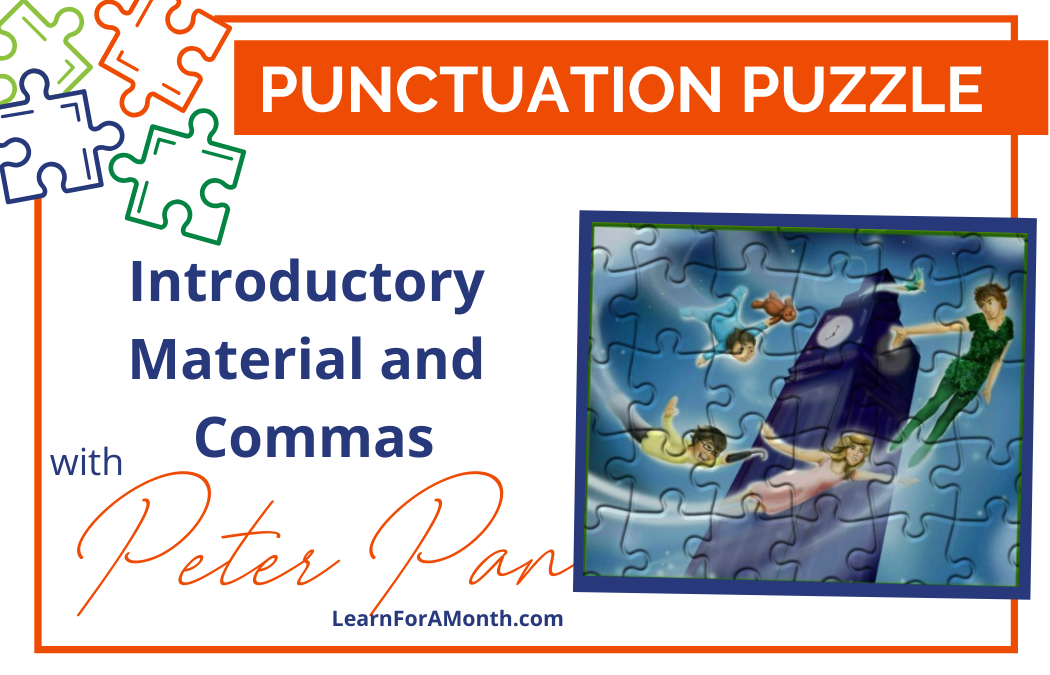By Donna Reish & Zac Kieser
Amazing Punctuation Puzzle this week! And not just because it is about a favorite attraction of mine at Disney World. (Btw, 267 days til our next family Disney trip!) Zac does an amazing job explaining sentence openers and comma use……but here is a Teacher Tip that I have been facing a lot lately: Students will never get a good handle on sentence openers (also called introductory material or non-essential information at the beginning of a sentence) UNTIL they have a handle on what a sentence contains.
In other words, they have to be able to tell the five parts of a sentence (CAVES–Capital; All Makes Sense; Verb; End Mark; Subject) before they can truly find and punctuate their sentence openers properly.
Here are some tips on working with students concerning base sentences and sentence openers:
1) Cover up all sentence openers with fingers. Say the “sentence” that remains aloud. Talk through the parts of a sentence. How can they know that a real sentence remains? It has to have a subject and verb. It has to make sense when it stands all alone.
2) Read sentence openers aloud with inflection where the comma goes. Teach students that the comma goes where the voice goes down. Teach that the “real” sentence begins when the sentence opener ends.
3) Read the sentence opener and discuss how it is NOT a real sentence. A sentence opener is added to a real sentence to give more information, change sentence rhythm, and provide conciseness. However, it is not a sentence itself.
4) Work extensively on sentences that do not have sentence openers, helping students get a handle on what a real sentence (without an opener) looks like.
5) Teach sentence openers one at a time, starting with the most familiar to them (usually prepositional phrase openers). (Check out my Preposition Practice Packet here or my Beauty and the Beast Preposition Practice Download here!)
6) Make it a habit of isolating sentence openers when dissecting sentences. I use the following protocol:
a. Place parentheses around all prepositional phrases.
b. Place brackets around all subordinate clause openers.
c. Place “less than/greater than” (<>) around all other openers
7) Use verb practice extensively. Every paper that students write for me has their verbs circled via my Checklist Challenge. Working with sentences in this manner helps students to see that a sentence must contain at least one verb in order to be a sentence. (See my Checklist Challenge packet and video here.)
8) Practice orally with the “Sentence/No Sentence” game. You say groups of words and have the tell you whether they are sentences or not and why.

Now on to our Puzzle…
Punctuation Puzzle – Introductory Material and Commas With Peter Pan
Having defeated Captain Hook Peter Pan tried to convince the children to stay in Neverland. However they were homesick and ready to return home.
The answer?
Having defeated Captain Hook, Peter Pan tried to convince the children to stay in Neverland. However, they were homesick and ready to return home.
Introductory Material and Commas
1. In this problem sentence, we have two problems, both of which have to do with introductory material and commas.
2. Commas have an incredible variety of uses; however, they are most often used following a number of different kinds of introductory material (sentence openers).
3. Let’s check out these various types of introductory material that use commas:
i. A subordinate clause opener – Because he was clever, Peter Pan was always able to defeat Captain Hook.
ii. A prepositional phrase opener – After escaping from Captain Hook’s ship, Tinkerbell quickly flew to tell Peter.
iii. An ing opener – Using his voice, Peter caused the pirates to start fighting each other.
iv. An ed opener – Filled with jealousy, Tinkerbell tricked Tootles into shooting at Wendy.
v. A short PP (prepositional phrase) that requires a comma – At night, Peter Pan and the Lost Boy slept in their hideout.
(A short PP requires a comma, if you, the writer, can hear a pause after the prepositional phrase. If someone else hears a pause, but you do not hear it, it is fine not to insert a comma.)
vi. A transition word or phrase – Then, Peter helped his friends escape from Captain Hook.
vii. An ly word (adverb) – Fortunately, Wendy was unhurt by the arrow.
viii. An ly phrase or clause followed by a comma – Quickly tying up everyone, Captain Hook and his men prevented Peter from learning of his friends’ plight.
ix. A conjunctive adverb – However, the pirates had learned where Peter and the Lost Boys lived.
x. An interjection – Yes, the crocodile terrorized Captain Hook.
xi. Other non-essential material of your choice – Ready with a plan, Peter Pan could always discover how to escape from Captain Hook.
4. There are two rules to remember when we use commas with introductory material:
i. Introductory Material and Commas Rule #1
A pause following any kind of introductory material means you need to use a comma.
Example:
Hearing the crocodile approaching, Captain Hook panicked.
(If we read this sentence, we can hear a pause after the word approaching, at the end of the ing opener, Hearing the crocodile approaching; therefore, we need to insert a comma here.)
ii. Introductory Material and Commas Rule #2
A sentence with a true sentence opener can stand alone, even if the opener is removed.
Example:
Sentence opener included – Hearing the crocodile approaching, Captain Hook panicked.
Sentence opener removed – Captain Hook panicked.
(In this example, we can see that we have a true sentence opener, because whether the sentence opener is included or removed, we still have a sentence.
5. In our problem sentence, we have two pieces of introductory material:
Having defeated Captain Hook Peter Pan tried to convince the children to stay in Neverland. However they were homesick and ready to return home.
6. The first piece of introductory material is an ing opener and we can hear a pause after it; therefore, it needs a comma.
Having defeated Captain Hook, Peter Pan tried to convince the children to stay in Neverland. However they were homesick and ready to return home.
7. The second piece of introductory material is a conjunctive adverb, so even though it is debatable whether it has a pause after it or not, it also needs a comma.
Having defeated Captain Hook, Peter Pan tried to convince the children to stay in Neverland. However, they were homesick and ready to return home.
Today’s Punctuation Puzzle sentence comes from a student writing assignment found in the Write On, Peter Pan downloadable writing series for grades two through twelve.


Trackbacks/Pingbacks